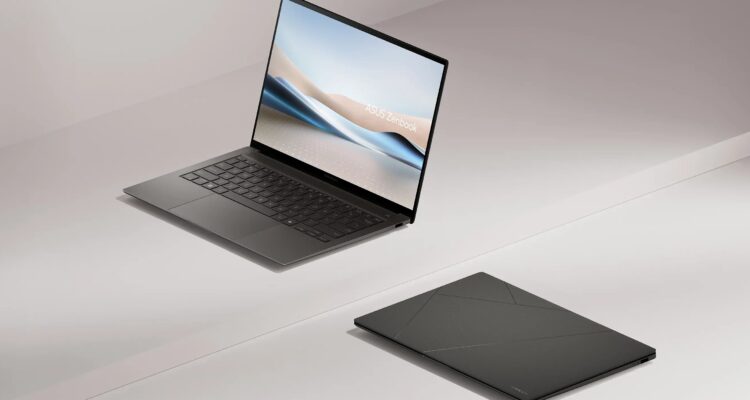ASUS’ latest entry in the Copilot+ PC space is such a fascinating beast.
A beast it is, with an impressive performance envelope ranging from productivity to the highest fidelity games, while still being efficient, compact, thin, and somehow, responsible.
Responsible is weird way to describe a laptop, but there’s something about the industrial design here that says class and style while the function under the hood is just trying to burst out.
The Zenbook S 14 boasts Intel’s Core Ultra 7 CPU built for AI workloads that are becoming more and more commonplace nowadays. And even if you don’t actively use AI tools, the vast majority of software written now uses it under the hood, so the Core Ultra in the Zenbook S 14 can handle them with impressive ease.
There’s a lot to love about this machine, and nary more than a few setbacks.
Starting with what you see: this device is thin, it’s light, and it’s sexy. Made out of what ASUS is calling Ceraluminum, a custom ceramic-aluminum blend engineered for strength and to resist fingerprints, it has a somewhat paper-like feel with the slightest bit of texture and tactility.
At 1.2kg, the Zenbook S 14 is a really svelte machine, and coming in at 1.19cm thin at its thinnest point, it’s only a hair thicker than the MacBook Air that it seems all notebooks aspire towards.
The backlit keyboard is incredibly bright (so much so that even the default brightness might be too bright), while the Zumaia Gray shell is a really great deep silvery gunmetal colour we’ve seen on ASUS’ previous Zenbook models.
But the display is really where the Zenbook S 14 shines. The 3K OLED touch panel is without a doubt one of the best notebook displays we’ve ever seen and used. Blacks are crisp, whites are bright, and colours are vibrant. Brightness tops out at 500 nits at peak, which is on par with other manufacturers, though it can dull out some colours at the 400 nits sustained brightness it offers.
There’s a coating on the display that makes it a joy to touch when other notebook displays tend to just be an afterthought when it comes to touch feel.
The keyboard is what you know from ASUS, though the travel on the standard chiclet keys has been reduced due to the thinner form factor overall. The trackpad takes up as much of the space between the keyboard and the lower edge of the keyboard as possible, though it is hinged at the top, and pressing the button takes some getting used to if you’re used to any of the ‘press-anywhere’ trackpads out there.
Connectivity hasn’t been skipped out on here, either with a full suite of ports including 10Gbps USB-A, two Thunderbolt 4 ports, a full-sized HDMI 2.1, and a mini audio jack.
But what of the innards?
Intel spec’d this machine out with a Core Ultra 7 processor, 32GB of RAM, and 1TB of M.2 storage.
This is a machine built on Intel’s new Lunar Lake architecture, which puts everything–CPU, GPU, NPU, RAM–in the same package for quicker communication between components which utilize a shared memory pool. 16GB is the base config for all Intel Lunar Lake CPUs, which aligns with Microsoft’s Copilot+ PC requirement of no less than 16GB of RAM to qualify.
The quick rundown is that this machine will hit Geekbench single core scores just above 2700 and multi core scores around 11200, while Assassin’s Creed Valhalla will run at up to 50 frames per second and Grand Theft Auto V gets well over 100 fps.
We tested out a variety of older games on the system as well, including the Tomb Raider reboot from 2013 and its sequels, before going way back and playing Command and Conquer: Generals which, unexpectedly, ran without a single hiccup.
Of course, the real story here is around AI workloads which, in all honesty, are kind of hard to test for if we’re not data scientists (hint: we’re not). But alas, Geekbench AI is a thing, and the Intel Core Ultra 7 performs quite well considering its place in the thin-and-light-but-with-actually-great-performance category of notebooks.
Skipping over the wonderchips of Apple’s iPad line that routinely score in the 50,000+ range, the ASUS Zenbook S 14 has a Quantized score north of 25,000, compared to the average Geekbench AI score pushing about 40% of that, in the 10,000 range. And yes, that average includes Apple’s devices. Comparable Windows devices are often in the 5,000 score range, highlighting just how much of a difference the Zenbook S 14 pushes.
Using the Zenbook S 14 really does make it feel like we’re using an ultraportable until we push it to do something and it suddenly performs like a laptop that is much beefier. The fan definitely spins up from time to time, and it’s not always cool with the down-firing fan, but these gripes may just be what we’re used to in the Windows world.
All that said, there is a lot to love about this machine, and it could very easily become a daily driver as well as an excellent option for those who game on the go or those who need to be productive alike.
The ASUS Zenbook S 14 line is out right now and can be ordered at Asus.com and select retailers.
This ASUS Zenbook S 14 we tested for this review was loaned by Intel. Read our reviews policy here.

